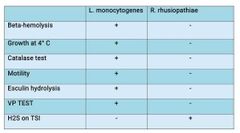![]()
![]()
![]()
Use LEFT and RIGHT arrow keys to navigate between flashcards;
Use UP and DOWN arrow keys to flip the card;
H to show hint;
A reads text to speech;
30 Cards in this Set
- Front
- Back
|
1. LISTERIA MONOCYTOGENES • |
• Primarily an animal pathogen • With tumbling motility or ("end-after-end motility") at room temperature (wet mount and hanging drop) - presumptive way to detect Listeria • Narrow band of Beta-hemolysis
|
|
|
• Forms the so-called "inverted Christmas tree" pattern/ umbrella like growth on agar surface SIM media • Cultured on Mc Brides media |
• Anton's test - virulence test/ ocular test of Anton, organisms inocculated in conjunctival sac of rabbit (+) purulent conjunctivitis |
|
|
• Diseases: |
1. Listeriosis - food poisoning 2. Septicemia - can infect blood 3. Meningitis in elderly and immunocompromised |
|
|
• Mode of transmission: |
- consumption of contaminated food, particularly COLESLAW and SOFT CHEESE |
|
|
• Virulence factor: |
Listeriolysin O - hemolytic cytotoxic toxin that allows survival of organism within phagocytes |
|
|
• CAMP test (+), can tolerate cold enrichment (4°C for several weeks) |
• CAMP test for Listeria uses: Rhodococcus equi known as organisms positive result: block type or shovel-type hemolysis |
|
|
2. ERYSIPELOTHRIX RHUSIOPATHIAE * |
* H²S positive on TSI media (it can cause blackening in large amount) * Non-motile * Catalase (-) |
|
|
* Causes erysipeloid, a localized skin infection; an occupational hazard for those handling meat and poultry and fish * Hemolytic pattern: can be either alpha usually or beta-hemolytic |
* On gelatin stab: 'bottle brush or test tube brush or pipe cleaner pattern of growth |
|
|
3. LACTUBACILLUS ACIDOPHILUS / DODERLAIN BACILLI ✓ |
✓ Produced large amount of lactic acid, non-pathogenic and has little clinical significance ✓ Can be seen PAP stain smear since it's a normal flora: abnormal increase of L. acidophilus may indicate DM or patient might taking contraceptives |
|
|
✓ Normal flora of mouth: GIT and vaginal canal (it can protect women form urogenital bacteria |
✓ Trivia: L. acidophilus can be a component of yogurt ✓ Culture media: TJA (Tomato juice agar) |
|
|
Gram (+) non spore forming bacilli |

|
|
|
4. GENUS CORYNEBACTERIUM ° |
° Non-motile, highly pleomorphic - can assume different forms; Bacillus with granules |
|
|
° Also known as, Klebs Loeffler's Bacillus |
Corynebacterium diphtheriae |
|
|
A very powerful exotoxin that attacks the mucous membrane of respiratory tract resulting to inflammation, following necrosis that can lead to pseudomembrane formation (cardinal sign for diphtheria infection) |
Diphtheria toxin |
|
|
Enhance granule formation and pleomorphism |
Loeffler's serum and PAI's coagulated Egg serum |
|
|
Small, moist, slightly raised grayish colonies with entire margin (poached-egg colony); enhances pigmentation of organism |
Loeffler's serum |
|
|
Enhances pleomorphism and granule formation; can produce gray to black colony |
PAI coagulated egg medium |
|
|
- it is a toxigenicity test to determine whether the organism is a toxin producer or not |
° Modified ELEK test positive (+) |
|
|
- Highly pleomorphic Corynebacterium organism - Has few metachromatic granules - Causes mastitis in cattle, an inflammation or infection of the breast |
Corynebacterium ulcerans |
|
|
Formerly Corynebacterium ovix; rare cause of lymphadenitis |
Corynebacterium pseudotuberculosis |
|
|
Normal flora of skin, nasopharynx and conjunctival sac |
Corynebacterium xerosis |
|
|
Also known as, Hoffman's Bacillus, normal flora of human oropharynx/ oral flora (throat flora) . It may cause endocarditis |
Corynebacterium pseudodiphtheriticum |
|
|
Causes erythrasma, a skin infection affecting axillary and pubic skin, produced coral red fluorescence when exposed to wood's lamp due to porphyrin |
Corynebacterium minutissimum |
|
|
Most commonly isolated, clinically significant C. spp |
Corynebacterium urealyticum |
|
|
Listeria vs. Corynebacterium: |
Listeria is both motile and salicin (+) while, Corynebacterium is non-motile and salicin (-) |
|
|
What is the disease diphtheria? |
It is a droplet infection characterized by low grade fever, mild sore throat and body weakness. *Patient may manifest a bull-neck appearance due to enlargement lymph nodes |
|
|
These colony types however have nothing to do with the degree/ severity of the infection. 3 colony types on CTA: |
Gravis Mitis Intermedius |
|
|
Largest colony type; dark grey colony with irregular edeges 1-2 mm in diameter |
Gravis |
|
|
Fried egg appearing organism in BAP |
Mitis |
|
|
Small and black colonies; 0.5 mm in diameter |
Intermedius |

